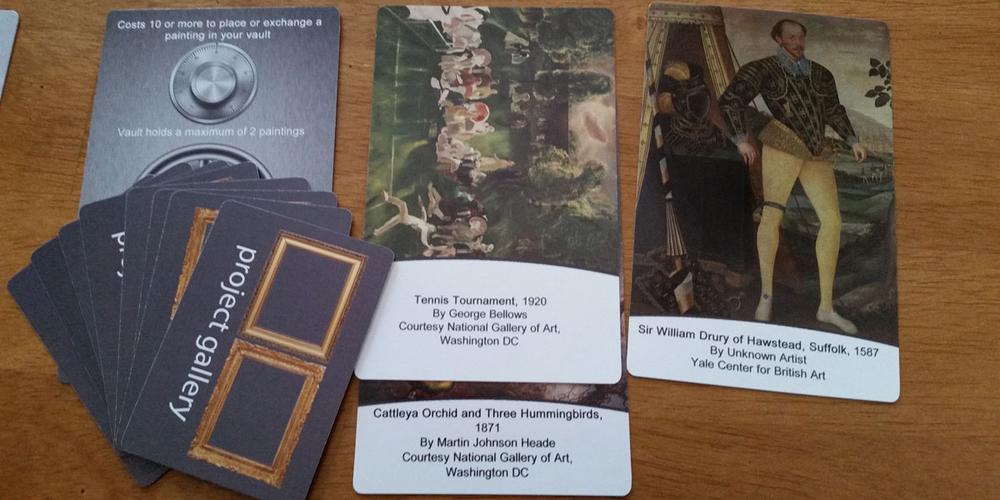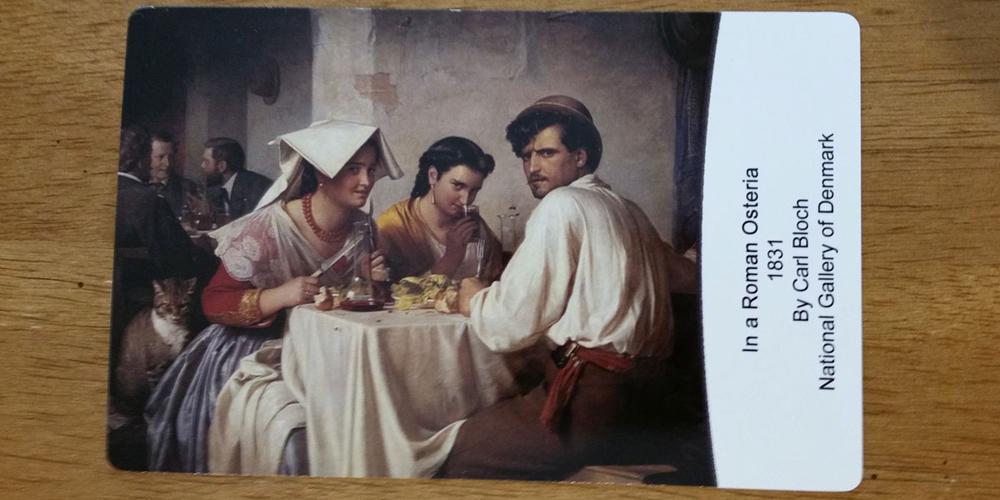
Project Gallery is a fun, fast-paced game set in the world of fine art galleries. It has a nice mix of luck and strategy, and adds in the potential to learn about some great works of art.
At a Glance:
In Project Gallery, players take on the role of the curator of an art exhibit, trying to collect paintings that match one or more themes. Paintings can be acquired via auction, loaned from existing galleries, or even stolen from other players’ collections.
The game is currently running a campaign on Kickstarter. You can get a copy for a pledge of $45.
New to Kickstarter? Check out our crowdfunding primer.
- Components:
- 78 paintings
- 104 resource cards
- 6 museum/art collector gallery boards
- 4 reference cards
- 4 vaults
- 2 dice
- 1 rule book
Note: I was sent a prototype of the game to test it. The quantity and appearance of the components may change by the time the game is fully produced.
How to Play:
Setting up the game is fairly simple: separately shuffle the paintings and resource cards. Deal three paintings and ten resource cards to each player. Put the remaining cards in each deck face-down on the table in two draw piles. Also give each player a vault and a reference card. Then, set out three of the gallery boards and randomly deal four paintings to each board (three each if there are only 2 players). Roll the dice to decide who goes first.

On each turn, a player has three options: she can acquire a painting, place a painting in her vault, or draw more resource cards.
The bulk of the game revolves around acquiring paintings, which can be done in one of three ways. The first is to buy a painting at auction. To do this, turn over the top painting from the paintings deck. The current player can either bid on it, or, once per turn, choose to discard it and see the next painting, which she can then bid on if she chooses. To bid, the player discards resource cards. These comprise the player’s hand, and are made up of cards numbered one through twelve. Also included are “clout” cards that are basically trumps. In order to bid, the player needs to discard resource cards adding up to at least ten, but no change is given. Then, any other player can choose to bid as well, also by paying ten in resource cards. Once everyone has been given the chance to pay to bid, all players involved in the auction choose a single resource card from their hand and place it face-down on the table. All of these cards are then revealed simultaneously, with the highest bid winning the auction. Clout cards are considered highest. The winning player discards her bid, but the losing players take their bid cards back into the hands. In the case of a tie, the tied players bid again, and continue to do so until there is a winner. At that point, the winner pays all of their bids by discarding, while the loser pays nothing.

If the player isn’t interested in bidding on the current painting, she may acquire a painting from one of the galleries on the table. Each gallery has a set range of prices, paid by discarding the appropriate resources. For example, paintings at the Galerie Charron require payment of three cards of 4, 5, 6 or clout. Any combination of those cards works, so the player could discard two fours and a clout, or three fives, or whatever. However, paying the gallery does not guarantee that you’ll get the painting, because once you’ve paid the resources you then need to roll the dice. Regardless of the gallery, you need to roll a six or higher on the two dice in order to get the painting. Failure to get the roll you need means that you lose the resource cards but don’t get the painting.
The third way to get a painting is to steal it from another player. Stealing is similar to buying a painting from a gallery, but statistically easier: you need to pay three cards of 7, 8, 9 or clout, and then roll, but here you only need to roll an even number. If you succeed, you get the painting from your opponent.
The second option on your turn, instead of acquiring a painting at all, is to put a painting in your vault. Each player has a vault that can hold up to two paintings, but they must have at least four paintings in order to put anything in, and they must keep three paintings outside the vault. There’s no luck involved in putting things in the vault–you just need to pay 10 in resources, but it does take a turn. Paintings in vaults cannot be stolen by other players.
Any player who elects for either of these first two options (acquiring a painting or putting a painting in the vault) draws a resource card and then ends her turn. However, if she is short on resource cards, there’s another option: she can basically skip her whole turn and in exchange draw three resource cards.
This continues, with each player taking turns, until someone collects five paintings in a single theme, at which time the game ends. Players tally their scores and figure out who won.
The Verdict:
We played the game several times over a weekend. It was an immediate big hit with the adults in the family. There was just enough strategy, mostly around resource management, to be interesting, but the mix of luck with the dice rolling kept everyone in the game until the end. There’s a ton of player interaction with the auctions and art theft, and turns are very quick.

The kids had a harder time getting into it, but that was due to one factor: the cards in the prototype aren’t labeled as to which theme they belong to. Most paintings are obvious: the Van Gogh self-portrait is clearly in the “Male Portraits” theme. But many belong to multiple themes, and some are very subtle–there’s one painting in there, “In the Roman Osteria,” that’s in the “Cat” theme, but the cat in the painting isn’t obvious at first glance. That’s part of the point of the game–designer Kate Jordan told me that she really wants people to look closely at the art–but my 10-year-old in particular found it very frustrating that he couldn’t be sure he was even collecting the right pieces, and didn’t like how the game kept having to pause for me to look up paintings in the list printed in the rule book.
Thankfully, however, this isn’t going to be a problem in the final game, as Jordan has also said that they are adding icons to the cards to identify which themes each belongs in. I think that give us the best of both worlds: the game can be nice and fast-paced, letting people quickly know that they’re getting the right paintings, but will still encourage looking at the paintings. Using the example above, anyone who plays the game will see the cat theme icon on “Osteria,” and curiosity will likely be enough to take a close look at it to find the cat.
Overall, the game is both fun and educational. I’ll definitely be backing and would recommend that you do too, and I can’t wait to see the finished version. It’s a game that will probably make it into some of my classes (I do, after all, teach at an art school), and I’m confident it’s going to make it to the table at home often as well.




